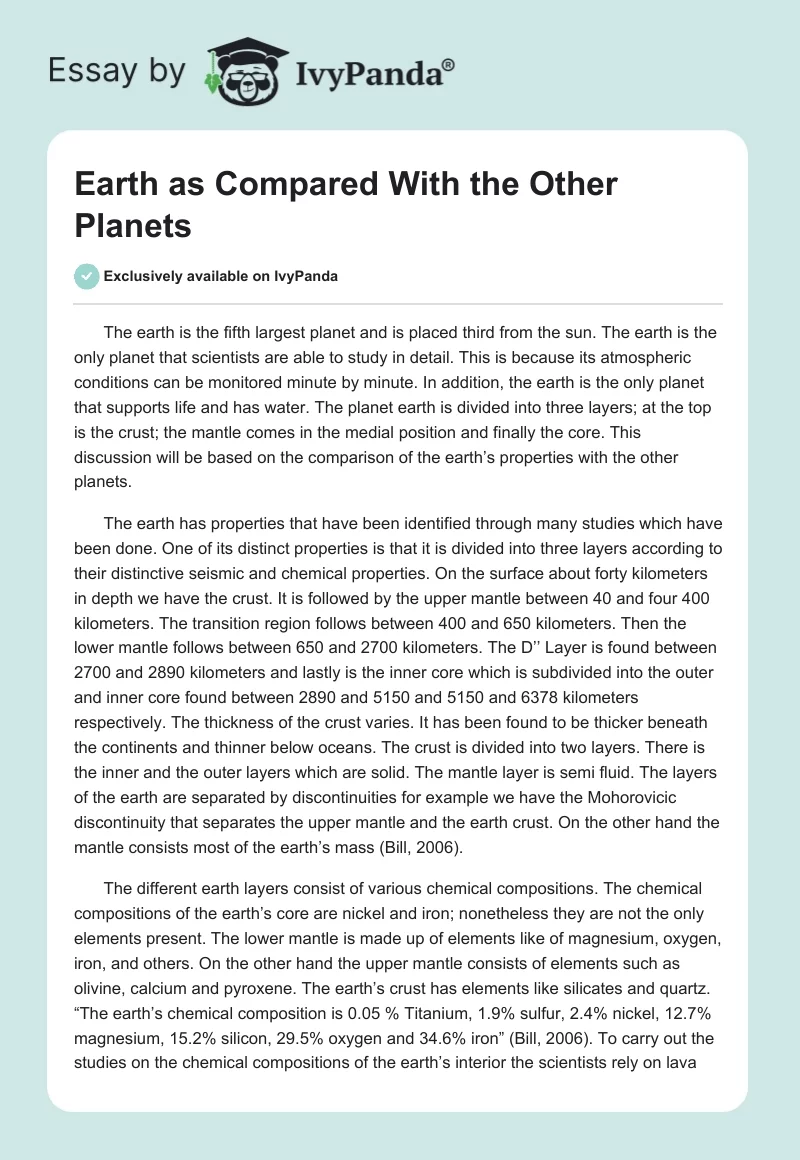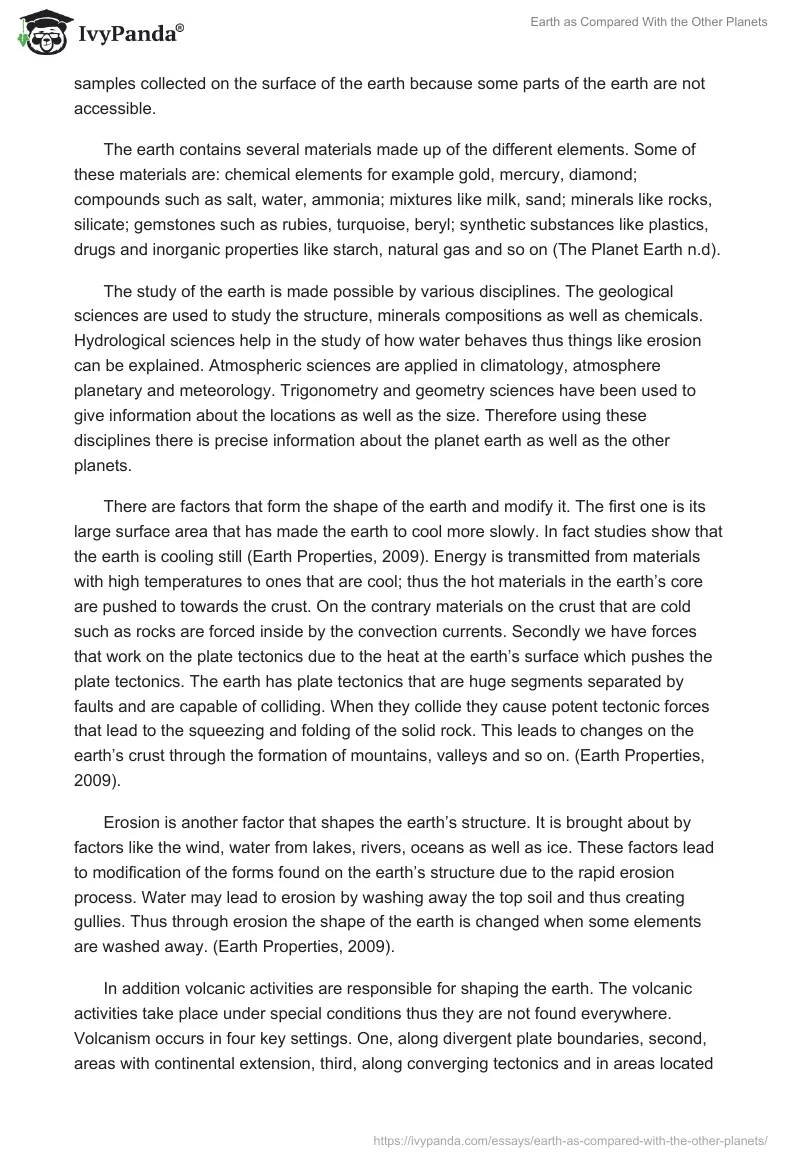The earth is the fifth largest planet and is placed third from the sun. The earth is the only planet that scientists are able to study in detail. This is because its atmospheric conditions can be monitored minute by minute. In addition, the earth is the only planet that supports life and has water. The planet earth is divided into three layers; at the top is the crust; the mantle comes in the medial position and finally the core. This discussion will be based on the comparison of the earth’s properties with the other planets.
The earth has properties that have been identified through many studies which have been done. One of its distinct properties is that it is divided into three layers according to their distinctive seismic and chemical properties. On the surface about forty kilometers in depth we have the crust. It is followed by the upper mantle between 40 and four 400 kilometers. The transition region follows between 400 and 650 kilometers. Then the lower mantle follows between 650 and 2700 kilometers.
The D’’ Layer is found between 2700 and 2890 kilometers and lastly is the inner core which is subdivided into the outer and inner core found between 2890 and 5150 and 5150 and 6378 kilometers respectively. The thickness of the crust varies. It has been found to be thicker beneath the continents and thinner below oceans. The crust is divided into two layers. There is the inner and the outer layers which are solid. The mantle layer is semi fluid. The layers of the earth are separated by discontinuities for example we have the Mohorovicic discontinuity that separates the upper mantle and the earth crust. On the other hand the mantle consists most of the earth’s mass (Bill, 2006).
The different earth layers consist of various chemical compositions. The chemical compositions of the earth’s core are nickel and iron; nonetheless they are not the only elements present. The lower mantle is made up of elements like of magnesium, oxygen, iron, and others. On the other hand the upper mantle consists of elements such as olivine, calcium and pyroxene. The earth’s crust has elements like silicates and quartz. “The earth’s chemical composition is 0.05 % Titanium, 1.9% sulfur, 2.4% nickel, 12.7% magnesium, 15.2% silicon, 29.5% oxygen and 34.6% iron” (Bill, 2006). To carry out the studies on the chemical compositions of the earth’s interior the scientists rely on lava samples collected on the surface of the earth because some parts of the earth are not accessible.
The earth contains several materials made up of the different elements. Some of these materials are: chemical elements for example gold, mercury, diamond; compounds such as salt, water, ammonia; mixtures like milk, sand; minerals like rocks, silicate; gemstones such as rubies, turquoise, beryl; synthetic substances like plastics, drugs and inorganic properties like starch, natural gas and so on (The Planet Earth n.d).
The study of the earth is made possible by various disciplines. The geological sciences are used to study the structure, minerals compositions as well as chemicals. Hydrological sciences help in the study of how water behaves thus things like erosion can be explained. Atmospheric sciences are applied in climatology, atmosphere planetary and meteorology. Trigonometry and geometry sciences have been used to give information about the locations as well as the size. Therefore using these disciplines there is precise information about the planet earth as well as the other planets.
There are factors that form the shape of the earth and modify it. The first one is its large surface area that has made the earth to cool more slowly. In fact studies show that the earth is cooling still (Earth Properties, 2009). Energy is transmitted from materials with high temperatures to ones that are cool; thus the hot materials in the earth’s core are pushed to towards the crust. On the contrary materials on the crust that are cold such as rocks are forced inside by the convection currents. Secondly we have forces that work on the plate tectonics due to the heat at the earth’s surface which pushes the plate tectonics. The earth has plate tectonics that are huge segments separated by faults and are capable of colliding. When they collide they cause potent tectonic forces that lead to the squeezing and folding of the solid rock. This leads to changes on the earth’s crust through the formation of mountains, valleys and so on. (Earth Properties, 2009).
Erosion is another factor that shapes the earth’s structure. It is brought about by factors like the wind, water from lakes, rivers, oceans as well as ice. These factors lead to modification of the forms found on the earth’s structure due to the rapid erosion process. Water may lead to erosion by washing away the top soil and thus creating gullies. Thus through erosion the shape of the earth is changed when some elements are washed away. (Earth Properties, 2009).
In addition volcanic activities are responsible for shaping the earth. The volcanic activities take place under special conditions thus they are not found everywhere. Volcanism occurs in four key settings. One, along divergent plate boundaries, second, areas with continental extension, third, along converging tectonics and in areas located in the interior of the earth’s plate called hot spots (Nelson, 2008). Through volcanic activities features like craters are formed when hot magma is forced out to the surface. The vent used by the magma may become a crater at the top. Some of the craters may retain water thus becoming lakes. All these features change the earth’s surface.
The earth is just one planet among seven others. It is the densest body and may have some similarities with the other planets. It is also one of the most important planets due to its ability to support all the living organisms. Its is also a unique planet because it is the only one that has liquid water except for some satellites in Jupiter that are said to have water and some scientists believe some form of bacteria exist. The earth can be used as a central point in comparing the rest of the planets in the solar system which has seven other planets; namely, Mercury, Venus, mars, Jupiter, Saturn, Uranus and Neptune.
The planet mercury is the closets to the sun. It has a larger core compared to the earth. It has a very eccentric orbit thus giving strange effects to observers on its surface. The observers saw at some point the sun stop as it moved towards the zenith. At the same time the stars would be moving at a very fast pace on the sky. The temperatures in mercury are very hot and this makes this planet the most extreme in temperature variations. The temperatures are very high and vary from between 90K and 700K. Due to these high temperatures no living things are found here unlike in the earth (Bill, 2006).
Venus is the other planet positioned second from the sun. This planet is very bright like the moon and the earth thus different from the earth in this sense. Its rotation is very slow that is about 245 days on earth to one Venus day and therefore it does not have a magnetic field. This planet is often called the Earth’s sister due to its similarities with the earth. To begin with their sizes are almost similar though Venus is slightly smaller. Both planets contain very few craters in addition they have similar chemical compositions as well as densities. Venus’ temperature is very hot and ironically its surface is hotter than mercury’s yet it is further from the sun. Therefore its surface is very dry as its water boiled away due to its high temperatures. In addition it does not have any satellites (Bill, 2006).
Mars planet has a red color and its surface is very cold. It is smaller than the earth but the surface are is just about the size of Earth’s. Both planets are similar in that they have an atmosphere; however the mars’ atmosphere contains typically of carbon dioxide though there is some oxygen just like in the earth. The two planets are similar in that the length of their day is almost equal. The earth has 24 hours while mars has 24 ½ hours. It has two satellites and its orbit is elliptical. Its unique characteristic is its terrain which is spectacular. This planet is said to have supported life though no prove has been found yet.
Jupiter is the largest planet is it is about 318 times the mass of the earth. It has a huge magnetic field which is stronger compared to the earth. Jupiter has a ring like Saturn but it is smaller in size and fainter. It has sixty three satellites. On the other hand Saturn is the second largest planet after Jupiter. It has rings around it and they are very bright. The rings are unstable and thus are regenerated by the processes ongoing like the break up of satellites. Just like the earth Saturn has a magnetic field. It has thirty four satellites. Saturn has the least density in all the planets (Bill, 2006).
Uranus is seventh from the sun and by diameter the third largest. Just like the earth Uranus contains rocks and ice. Its core is not rocky and hence the material at the core is less evenly distributed. Its magnetic field is peculiar because it is not found at the center like in other planets. Its rings are darker than Jupiter’s. Lastly there is Neptune. It comes in the eighth position from the sun. It has a rich blue tint in color which is as a result of the absorption of the red light by methane. The winds found in this planet are the fastest of all winds in the entire solar system. It radiates its own heat from its internal heat source. It has thirteen satellites (Bill, 2006).
The earth remains the only planet that supports life due to its favorable conditions that support life. However there is a reason to be alarmed with the level of greenhouse gases being released into the atmosphere thus leading to the rising of global temperatures. This has led to erratic rain patterns in most parts of the world and this has created shortages in food production, water to produce hydroelectric power and so on. Action needs to be taken now to protect our planet and avoid the rising of the temperatures least we find in uninhabitable conditions.
Reference List
- Bill, A. (2006), Earth. Web.
- Nelson, A.S. (2008). Volcanic Landforms, Volcanoes and plate Tectonics. Web.
- The Planet Earth.
- Properties of Earth and the Moon n.d.


